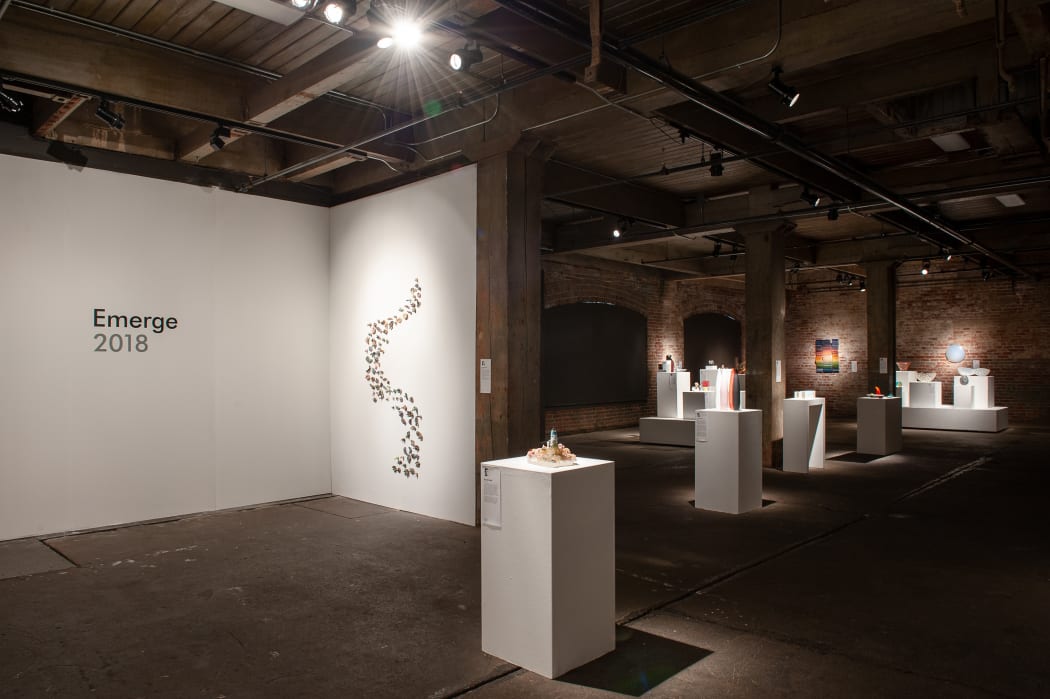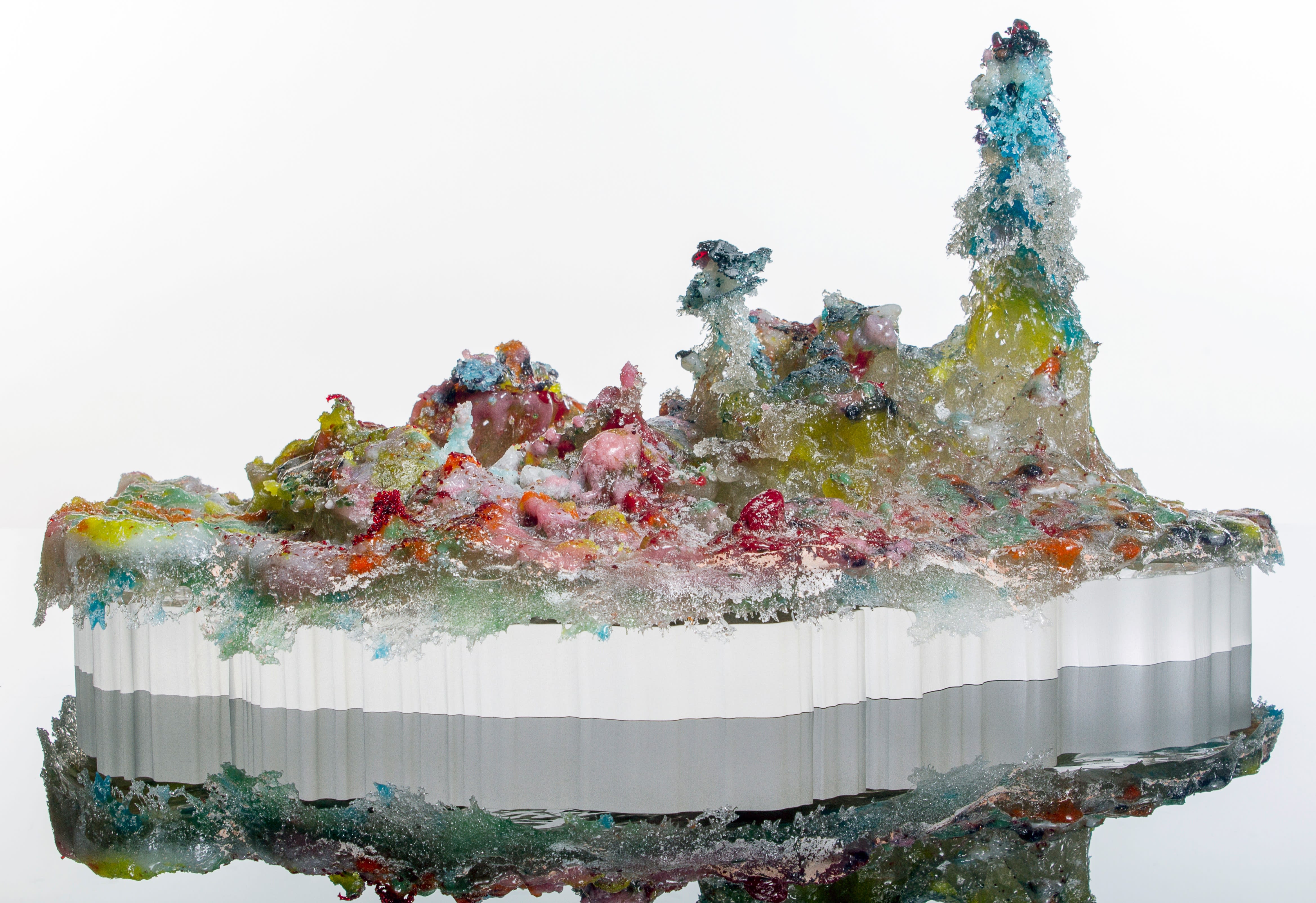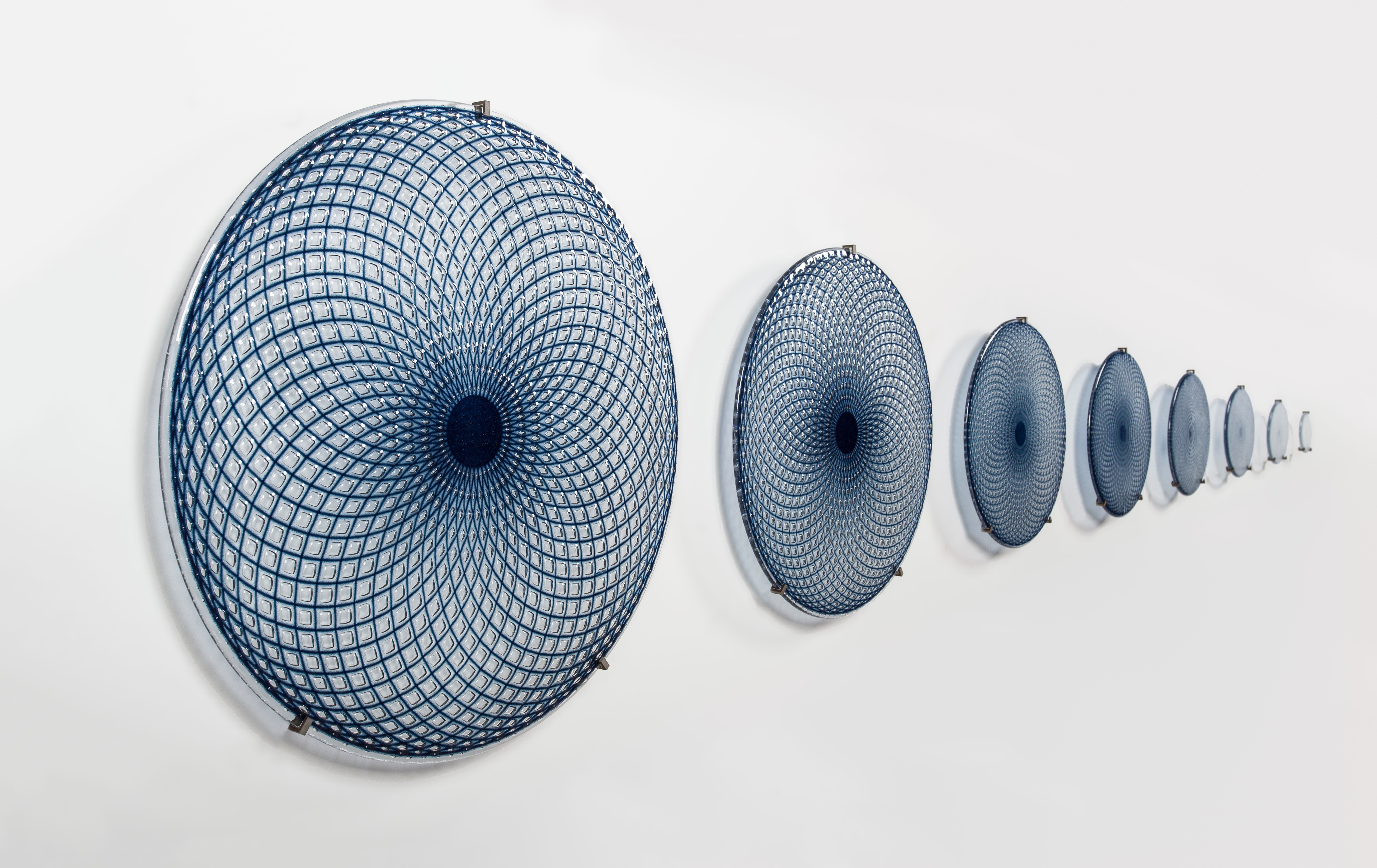
Emerge 2018 is Bullseye Glass Company's tenth biennial juried exhibition for rising talent in kiln-glass. Three jurors were tasked with reviewing hundreds of entries, selecting a group of finalists, and then selecting seven award winners. After the jury process ended, Bullseye Projects curator Michael Endo sat down with jurors Heidi Schwegler, Diane Wright, and Benedict Heywood to discuss the award winners, the competition, and the landscape of contemporary glass. An edited excerpt of that conversation is published in the catalog Emerge/Evolve 2018: A Showcase of Rising and Evolving Talents in Kiln-Glass.
What follows here is the first part (one of four sections) of an only slightly edited transcription of the entire conversation. The jurors discuss their approach to the process, offer suggestions for the future, and task future entrants to consider, "why glass?". In addition to Michael Endo and the jurors, Mary Kay Nitchie, Bullseye's Marketing Manager, and Lani McGregor, Director of Bullseye Projects, were present.
Michael Endo: You were asked to evaluate each piece based on the quality of concept, craftsmanship, and design. Did one of these criteria matter more than the others?
Heidi Schwegler: For me, I felt like because there was such a range, from material exploration to content-driven work, that rather than focus on craftsmanship or design, it became more about where the emphasis was more prevalent in each piece. I began to look at it through that lens. So it was interesting to try to put the emphasis on one of the three, rather than thinking that the whole group needed to have a hierarchy.
Diane Wright: I'm really glad you gave us these three criteria to think about, because this is similar to how I evaluate work in my curatorial practice. I have a three-pronged approach. I want a work to be very visually compelling, I want it to say something in terms of concept or idea, and I also want it to be well made. It's a balance of those three. But I have to say, I do try to see where one might outweigh the other. A little bit like what Heidi was saying, sometimes a strong concept can make up for a lack of strength in another area. But for me, a work really does need to touch at least somewhere in all three of those areas to come together and make something that is strong enough to hold its place in a special exhibition or museum collection.
Benedict Heywood: The unifying concept for me of all those is really trying to understand whether the work has some element of self-consciousness to it. The work is aware of why it needs to be made, an awareness of what it's supposed to do. I think work becomes weak when it doesn't have a strong reason to be made.
Michael: Can you expand on that a little bit? How does a piece have awareness?
Benedict: The piece expresses its purpose well and that you...well, obviously, you can have an object that is beautifully made, but if there is no reason for it to be made, then you wonder why someone bothered to make it in the first place. So as I said, a kind of self-awareness or instrumentality is important for me.
Heidi: I like that idea because I think sometimes, especially in this contemporary moment, artists feel as though their work has to have some kind of content or idea behind it. And sometimes it's okay for there to just be formal beauty, and that, in and of itself...
Benedict: Is also an end.
Heidi: So if I can piggyback on what you're saying, this idea of just owning what the primary intention is can actually make the piece stronger. Don’t shy away from pure formal aesthetics and design. Don't tack something on because you think it's going to make it stronger. Just understand that formal decisions, beautiful composition, and just beauty in general, in and of itself, is content.
Benedict: There were a number of works in the original jury process which I found interesting because they were incredibly well crafted, had a high degree of skill, but then the artist felt the need to say, “…well, you know, it's about this.” Well, you can just be about yourself but you need to own whatever you are.
Diane: As a decorative arts historian, that's an idea that I absolutely embrace; the idea that beauty has value. Our lives are made more interesting and are improved by having beautifully crafted and designed objects around us.
Michael: We've maintained these three criteria for over a decade. As an educator, Heidi, or as curators, Benedict and Diane, do you feel there's anything else jurors should consider?
Heidi: I don't know how this would be a category, but I'm interested in, specifically with glass, this notion of experimentation, a level of innovation. Is there a way to work with glass and acknowledge the fact that maybe you're trying something that isn't quite succeeding, but it's a new way of approaching the glass? I don't know how you would word that, but a level of material innovation could be an interesting category, specifically for Bullseye. Can that then be a new category that will then task other artists across the globe to want to try to work with glass because they know it is a category in this exhibition?
Mary Kay Nitchie: This makes me think of Catharine Newell's piece that was in one of the very first Emerge competitions. It was the first time, I think, that we had ever seen her work, and in the criteria that we were using it didn't get a place. It became the first honorable mention because we all looked at it and said, "this person needs to keep doing this." We hadn’t seen anybody work with glass that way before. She did continue to work with it. I could see a place for that category.

Catharine Newell’s “Blue Woman” was awarded Honorable Mention in 2001.
Heidi: There were several moments in this show alone where, I mean, I'm not coming from a really long history with glass, but I feel like there are moments in there where I'd never seen anything like that before. Maybe the piece wasn't as successful, but to somehow acknowledge that.
Michael: Which pieces are you referring to?
Heidi: Jade Tapson’s Scale II. Maybe that is very common, but I was just completely hypnotized because I couldn't understand how it was made and it felt really quite innovative for me. And also there are two artists: Lindsy Marshall, New Land Forms, and Daniel Rollitt, Fragility. I felt like they were working with the anti-aesthetic of glass, so in a way, being somewhat experimental. They were really outstanding in the show because the way they were using glass felt very different than the rest of the works.

Lindsy Marshall, "New Land Forms", 2017, kilnformed glass, 72 x 36 x 2 inches (installed).
Diane: I really would second that idea of innovation being something that is important to talk about and think about. In the curatorial and academic worlds you do see these trends and the same ideas are repeated over and over. So when something new does come along you're like, wow, I'm gonna go look at that and figure out why that's interesting and what they've done. It would be great to hear people talk a little bit about, in their statements, why they tried something new or what direction they were headed in.

Daniel Rollitt, "Fragility", 2018, pâte de verre, 6.875 x 13.5 x 8.75 inches
Michael: Do you mean a technical statement as well as an artistic statement?
Diane: It would probably be really helpful to have people give a little bit of explanation. I know we had some conversations about, “oh, I wonder how difficult this is to do, or that is to do, or, I wonder how that was made.” You can run the risk of being too focused on process and technique, but I think it's important for some consideration. Especially if you're talking about innovation.
Heidi: One of the things that really struck me about our specific trio is exactly that. None of us are very well-versed in the history of this sort of making in glass. So we could only approach it formally and then with the artist statement, without a sense of how it was made. And typically with a craft tradition, to fully judge something, you also understand the making, because that adds to your understanding of the piece. So I thought that was really wonderful; that we didn't have that and we could only approach it through what it was that we were seeing in front of us.
Diane: Well, people are doing so many different kinds of things now. I mean, I can look at a 16th century Italian piece and describe what they're doing, and yet today there's such a huge variety of techniques and materials that I find it really helpful to have a little additional explanation of where somebody was coming from in terms of process.
Benedict: Speaking as a representative of a museum, a low-level criterion would be thinking about how well this is going to fit in an exhibition. How compelling are these objects for a generalized, broadly curious, yet broadly uninitiated audience? How compelling are these going to be for those people? People are very, very interested in how things are made, and that's just something that audiences are always going to be interested in and you can't say, “well don't be interested in that, look at the object,” because they're not going to do that. Especially with this material. People have an intense curiosity about how glass is made.
Mary Kay: Is that something you'd like to see on the application, a certain number of words dedicated to summarizing how something was made?
Heidi: I think it should be with the artwork.
Benedict: Well, I'm conflicted because I'm also curious, but then it seems another thing to ask an artist to do.
Diane: Well, they can give a short explanation. I think we all wanted to know what Jade Tapson did on her piece.

Jade Tapson, "Scale II", 2017 kilnformed glass and screenprinted glass powder, 21.875 x 122.375 x 0.25 inches (installed).
Heidi: And that's why I think if there were another category that was really about innovation within the material, that's probably what the artist statement would be, purely talking about the process because that's the motivation in the content of the work.
Mary Kay: So you're saying they would nominate themselves for that category?
Heidi: Yes. I think it would be a really lovely subcategory. Because, especially if you have students, there can be a lot of material exploration… and to honor that so that we're not looking at a final finished object, but at what they discovered through the process. I’m always trying to encourage people to make a pile of mess because they're allowing the material to teach them something new about it, and it's not motivated by making this blingy thing at the end of the road, it's more about deepening your understanding of the material.
Diane: And if you ask them to say how they are innovating with this material, or why they chose glass, that forces them to think about it. We asked that question when we were looking at some of these pieces. Why would this piece be made out of glass, would it have been more interesting in another material?
Benedict: You know, there are way easier ways to make art than messing with glass.
Heidi: And cheaper.
Benedict: Cheaper, easier, in every sense of the word. So picking glass is always slightly perverse.
Diane: Oh, there's our quote for the day. …What is the motivation? I think that would be a really great question. Why are you motivated to choose this material? I would love to read the answers to that from all these artists and go back.
Read more:
Emerge Jury interview (part 2 of 4)
Emerge Jury interview (part 3 of 4)
Emerge Jury interview (part 4 of 4)
An edited version of the interview is included in Emerge/Evolve 2018: A Showcase of Rising and Evolving Talents in Kiln-Glass, available for purchase at bullseyeglass.com.